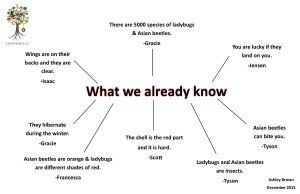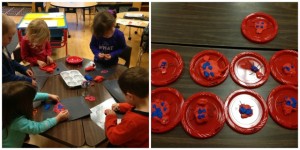As I watched the children from our St. Anne School Age Program explore outside I noticed many were captivated by the ladybugs crawling all over the wall of the school. I stood back to watch as the children examined them closely and listened as conversations transpired.
I soon realized the children knew a lot about ladybugs. The children recognized and could explain the differences between ladybugs and Asian beetles, what their black spots meant, and many referred to the folklore saying that a ladybug brings good luck to a person on whom it lands.
We know that children learn best when their learning is driven by their own interests and curiosities. Children are naturally motivated to investigate and learn. As an educator, I am always looking for new opportunities for children to deepen their thinking about something that has sparked their curiosity and most often find it like I did here, while observing and listening carefully to children at play.
Seeing how fascinated the children were with these insects, and hearing them ask questions that I didn’t have the answers for, provided a perfect opportunity to delve further. I proposed these questions to the children, “What do we already know about ladybugs?” and “What would we like to know about ladybugs?” There were a lot of things that the children still wanted to know, so we decided to do a little research together to find the answers.
The following day I laid out a variety of different sized magnifying glasses and containers for the children to examine the ladybugs up close, as well as paper with clipboards for them to write or draw their observations. As an educator, I am always looking for opportunities that invite children to further explore their interests in a manner that encourages collaboration, reflection and communication. Throughout our ladybug investigation I noticed how the children were drawn to one another, helping each other see the ladybugs in different ways and angles, as well as guiding each other on how to get the insects to crawl onto their fingers or into a container. It was wonderful to see the knowledge the children already had of these insects; it was even more rewarding to see the new information they were gaining from one another.
With the children being so engaged with the ladybugs and after spending significant time examining them closely, I offered them the opportunity to represent the differences between ladybugs and Asian beetles through drawings. To further their desire to create more lifelike ladybugs, the children used their observations and drawings to create 3 dimensional clay ladybugs.
To further this perspective we then decided to make larger 3 dimensional versions of ladybugs using balloons, paper mache, paint, and pipe cleaners. These were fun ways to explore new art materials and led to even more discoveries. As the children were making their paper mache ladybugs, they questioned how they were going to make the bottom of the ladybug because it was currently hollow. This question made us examine the ladybugs underside even more closely using 3 dimensional mirrors and bug finder lenses. The children came up with great ideas together and decided as a group they would glue brown construction paper underneath and shade it with black or brown paint. It was so rewarding to see the children working together, creating ladybugs and Asian beetles with incredible detail – even anatomically correct!
At Compass ELC, we view curriculum as everything that happens during our time together. By truly being present with children, we were able to observe their genuine curiosity in the world around us, specifically the common ladybug. Children gain newfound understanding as they explore the world around them and all that lives within it. Through our time investigating ladybugs the children were able to discover their unlimited potential for learning and it was the perfect way to show them how their voices are visible as partners in learning.
Submitted by: Ashley Brown RECE, Compass ELC School Age Program – St. Anne Elementary School, Peterborough
To read previously posted Compass ELC Blogs, please click HERE





